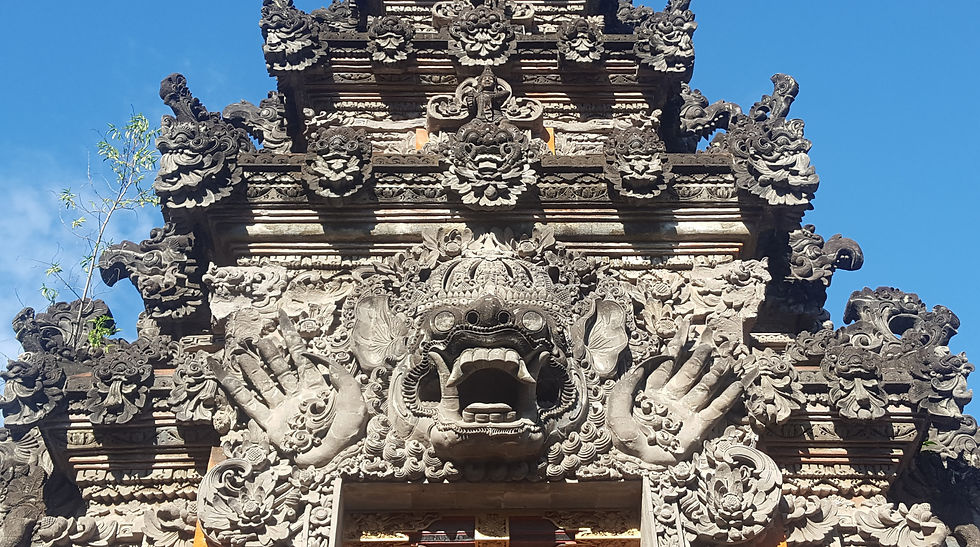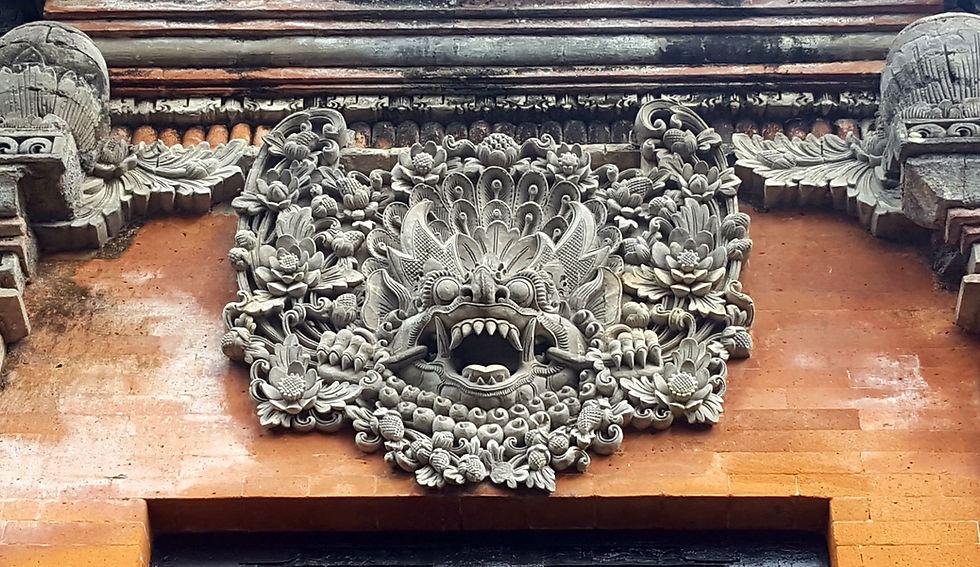Bhoma - Bali's Protector and Judge
- Shannon
- Aug 31
- 3 min read
In the architectural language of Balinese temples, Bhoma statues are not merely decorative but play a protective and symbolic role. Bhoma is derived from the ancient Sanskrit word bhūma, meaning “Earth” and is considered a guardian spirit linked to fertility, the forest and subterranean realms. Usually mounted above temple gates or embedded within sacred water features, these fierce, leaf entwined figures serve as guardians of spiritual boundaries.

Carved with bulging eyes, wild manes and open fanged mouths, Bhoma is not a demon but a manifestation of primordial earth energy, both untamed and fertile. He stands where the physical and spiritual worlds meet, keeping malign forces at bay while blessing those who pass beneath him with purification and grounding.

Bhoma’s mythological origin lies in Balinese Hindu adaptations of ancient Indian epics. He is said to be the offspring of Vishnu (worshipped in his aspect as Narayana) and Pertiwi, the Earth Mother. This divine pairing of heaven and earth represents the merging of celestial essence with terrestrial life, an idea central to Balinese cosmology.

Bhoma stands as the living embodiment of that union, a force of emergence, tied to the hidden veins of water, the swelling roots of trees and the quiet power of the land. His face, bursting with carved vines, twisting shoots and curling tendrils, speaks not of menace but of sacred vitality. In him, the earth is not passive, it protects, nourishes and remembers. He is both gatekeeper and a symbol of the deep bond between the natural world, the divine and the human soul.
In Balinese temples, Bhoma statues are commonly positioned above the candi bentar (split gates) or mounted over the paduraksa, the ornate entrance leading into the temple’s inner sanctum. Positioned high above the head like an all-seeing force, he gazes downward and acts as a spiritual filter. All who pass beneath are symbolically examined, stripped of unseen impurities and invited to leave their worldly chaos behind.

Bhoma enforces a threshold between the outer realm (nista mandala) and the sacred core (utama mandala), a task that requires not gentleness but uncompromising strength. His fearsome expression isn’t meant to intimidate the devout but to repel spiritual pollution, misfortune and any hidden force seeking entry into the sacred space.

One of Bhoma's more sacred roles lies in his connection to water and purification. At many temple springs and bathing pools, sacred water flows directly from his gaping mouth. This placement is deliberate, it reflects his origin as a force of the earth and his role as a channel of life giving energy. The water that pours through him is not merely physical, it carries spiritual weight, offering renewal to those who receive it.
Before entering the inner temple or participating in rituals, worshippers bathe in these flows, allowing their bodies and spirits to be realigned with the sacred order Bhoma protects. Beyond protection, Bhoma enforces cosmic equilibrium. Balinese temples are not just places of worship, they are microcosms of the universe, meticulously aligned with principles of balance, direction and energy. Bhoma, with his unruly features and forest born form, disrupts spiritual stagnation and dissolves excess. He absorbs chaos, interrupts malevolent forces and keeps energy flowing, a carved reminder that even divine order depends on wild, untamed power to sustain it.

Despite his fearsome appearance, Bhoma is not malevolent. Unlike other protective figures such as the Dvarapala, who are depicted standing guard with weapons in rigid symmetry, Bhoma appears wild, organic and animated, his form alive with motion. Yet he is deeply revered as a benevolent guardian, especially over children, homes and sacred temple grounds.

Balinese artisans often carve him with expressive detail, wide, all-seeing eyes, a roaring mouth frozen in mid-snarl and hair that twists like living vines. These motifs link him to both the wildness of nature and the intentional symbolism of Balinese sacred design. He does not wield weapons. His weapon IS the earth. The creeping, devouring and fertile earth that sustains but also reclaims.
In modern Bali, Bhoma’s image continues to evolve and endure. While his role in temple architecture remains traditional, he is also carved into decorative panels, home shrines and even hotel entrances across the Island of the Gods. Whether sculpted centuries ago or newly placed above a threshold, Bhoma figures continue to remind Balinese Hindus of the enduring need to guard the sacred, honour the earth and preserve harmony between humans, gods and the natural world.

He is the earth’s voice carved in stone, the protector, the purifier and wild companion to the divine. Bhoma does not demand worship. He simply stands, silently roaring, a presence that both warns and welcomes. His message is clear, the sacred is not something separate or distant, it rises from the soil beneath us, rooted in the same world we all walk every day.

Thanks for reading about Bhoma - Bali's Protector and Judge. Check out more awesome legends here!


























